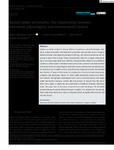Beyond spider personality: The relationships between behavioral, physiological, and environmental factors
| dc.contributor.author | Hernández Duran, L | |
| dc.contributor.author | Wilson, DT | |
| dc.contributor.author | Briffa, Mark | |
| dc.contributor.author | Rymer, TL | |
| dc.date.accessioned | 2021-09-20T10:31:18Z | |
| dc.date.issued | 2021-04 | |
| dc.identifier.issn | 2045-7758 | |
| dc.identifier.issn | 2045-7758 | |
| dc.identifier.uri | http://hdl.handle.net/10026.1/17842 | |
| dc.description.abstract |
<jats:title>Abstract</jats:title><jats:p>Spiders are useful models for testing different hypotheses and methodologies relating to animal personality and behavioral syndromes because they show a range of behavioral types and unique physiological traits (e.g., silk and venom) that are not observed in many other animals. These characteristics allow for a unique understanding of how physiology, behavioral plasticity, and personality interact across different contexts to affect spider's individual fitness and survival. However, the relative effect of extrinsic factors on physiological traits (silk, venom, and neurohormones) that play an important role in spider survival, and which may impact personality, has received less attention. The goal of this review is to explore how the environment, experience, ontogeny, and physiology interact to affect spider personality types across different contexts. We highlight physiological traits, such as neurohormones, and unique spider biochemical weapons, namely silks and venoms, to explore how the use of these traits might, or might not, be constrained or limited by particular behavioral types. We argue that, to develop a comprehensive understanding of the flexibility and persistence of specific behavioral types in spiders, it is necessary to incorporate these underlying mechanisms into a synthesized whole, alongside other extrinsic and intrinsic factors.</jats:p> | |
| dc.format.extent | 2974-2989 | |
| dc.format.medium | Electronic-eCollection | |
| dc.language | en | |
| dc.language.iso | en | |
| dc.publisher | Wiley | |
| dc.subject | behavioral plasticity | |
| dc.subject | behavioral type | |
| dc.subject | environment | |
| dc.subject | experience | |
| dc.subject | ontogeny | |
| dc.subject | venoms | |
| dc.title | Beyond spider personality: The relationships between behavioral, physiological, and environmental factors | |
| dc.type | journal-article | |
| dc.type | Journal Article | |
| dc.type | Review | |
| plymouth.author-url | https://www.webofscience.com/api/gateway?GWVersion=2&SrcApp=PARTNER_APP&SrcAuth=LinksAMR&KeyUT=WOS:000625780400001&DestLinkType=FullRecord&DestApp=ALL_WOS&UsrCustomerID=11bb513d99f797142bcfeffcc58ea008 | |
| plymouth.issue | 7 | |
| plymouth.volume | 11 | |
| plymouth.publication-status | Published | |
| plymouth.journal | Ecology and Evolution | |
| dc.identifier.doi | 10.1002/ece3.7243 | |
| plymouth.organisational-group | /Plymouth | |
| plymouth.organisational-group | /Plymouth/Faculty of Science and Engineering | |
| plymouth.organisational-group | /Plymouth/Faculty of Science and Engineering/School of Biological and Marine Sciences | |
| plymouth.organisational-group | /Plymouth/REF 2021 Researchers by UoA | |
| plymouth.organisational-group | /Plymouth/REF 2021 Researchers by UoA/UoA04 Psychology, Psychiatry and Neuroscience | |
| plymouth.organisational-group | /Plymouth/Research Groups | |
| plymouth.organisational-group | /Plymouth/Research Groups/Marine Institute | |
| plymouth.organisational-group | /Plymouth/Users by role | |
| plymouth.organisational-group | /Plymouth/Users by role/Academics | |
| plymouth.organisational-group | /Plymouth/Users by role/Researchers in ResearchFish submission | |
| dc.publisher.place | England | |
| dcterms.dateAccepted | 2021-01-08 | |
| dc.rights.embargodate | 2021-9-21 | |
| dc.identifier.eissn | 2045-7758 | |
| dc.rights.embargoperiod | Not known | |
| rioxxterms.versionofrecord | 10.1002/ece3.7243 | |
| rioxxterms.licenseref.uri | http://www.rioxx.net/licenses/all-rights-reserved | |
| rioxxterms.licenseref.startdate | 2021-04 | |
| rioxxterms.type | Journal Article/Review |


